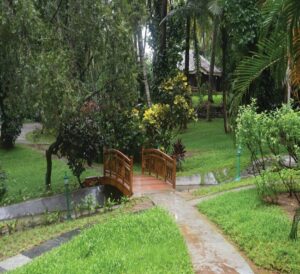 A bridge straddles a monsoon stream at the Kairali Healing Village, Palakkad
A bridge straddles a monsoon stream at the Kairali Healing Village, Palakkad
The touch of the therapists’ fingers felt like the flutter of butterfly wings on our bodies. Slowly, the pressure intensified and the four-handed massage by two therapists became a lesson in synchronicity – hands sliding up and down our bodies like a musical instrument being strummed by maestros. Our bodies melted into the teak wood table and our minds turned inward in the deep silence, igniting a love for life that had been virtually extinguished by the harsh realities of the pandemic.
We were at Kairali Healing Village in Palakkad, Kerala, and the soft sing-song cadence of our therapists’ voices were as soothing as the green vistas outside. A 63-acre green haven of paddy fields, organic farmland, vegetable and herb garden, with a stream winding around it, the Ayurvedic resort snuggles in just 15 acres of this forest-like landscape. Indeed, the Kairali Ayurvedic Group, a pioneer in promoting Ayurvedic retreats and treatment centres globally, was the first to promote Ayurveda therapies in India, way back in 1989. It prides itself on being rooted in pure Ayurveda.
We were at Kairali for a three-day restorative break in the monsoons, the best time it is believed for Ayurveda’s regimen of detox, as one’s pores are open and receptive to the healing oils and ministrations. We adhered to a strict 5,000-year-old Ayurvedic regimen that helped us balance our doshas. (Doshas are the three life-giving energies of Ayurveda such as vatta or air, pitta or fire and kapha or water which mould a person’s mind, body and even type of skin and hair.)
The days and nights slipped past in slow motion in a blur of restful therapies based on ancient scriptures, and yoga and meditation sessions in the new Yoga Deck with its floor-to-ceiling glass doors. While we contorted our bodies, rain pitter-pattered outside and the lush vegetation glistened as though the Gods had gone amok painting the world in various shades of green. While younger more nimble guests followed the yoga instructor’s whispered commands, we floundered, creaky joints and ageing limbs refusing to obey. During mindful meditation, the red-tiled, wood-beamed ceiling of the Yoga Deck reverberated with the sonorous chanting of Oms. Was our utterance of the ultimate cosmic sound laced with pain? At night we slept like babies, slight joint pain banished into the forest that surrounds this green jewel.
The fluid rub-downs with medicated herbal oils left us
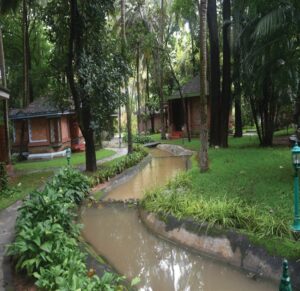 A stream winds around rain-washed villas
A stream winds around rain-washed villas
feeling limbered up and brimming with good health. After years of neglect, our skin felt supple, our joints did not squeak like a large pair of rusty shears. The classic abhyanga was done by two sari-clad therapists whose brisk rhythmic strokes danced and did cartwheels across the tense knots in our bodies. During another session, herbal poultices were rubbed on our stressed joints, and after a shirodhara or oil-drip treatment, we felt disassociated from our bodies. Shirodhara is said to ease headaches and insomnia. The kashaya dhara – a brisk massage followed by the masseuse trickling streams of medicated warm water felt like gentle rain falling all over our bodies which revelled in this new-found coddling… Were we afloat and buoyant in a warm sea?
We looked forward to the relaxing massages and the simple wholesome meals like desperate Bedouins in search of an oasis in the desert. We relished organic vegetarian meals for breakfast lunch and dinner, washed down with a rose wine look-alike called paithimugham, reputed to be a blood purifier. Nature invaded the cosy dining area in gentle shafts of sunlight and vistas of vibrant green outside. Over nutrient-dense healthy meals, we swapped life histories with guests from across the world who had come in the hope of curing injured knees, arthritis, cervical spondylosis, weight loss, relief from the symptoms of Parkinson’s disease, and just a pure detox. All of them left feeling feisty and fit and were determined to return.
Most guests had opted for the rigorous panchkarma therapy which requires one to stay for 15 to 21 days and involves living in a tranquil environment, consuming a diet designed to suit the patient, yoga, meditation, oil massages, purges and enemas. Some guests said they felt a sense of renewal after panchkarma, of living in a new body and of having sloughed off the old one. Friends who had such ‘out-of-the-old-body’ experiences, tried to persuade us to opt for panchkarma too but fear of the unknown held us back. We were addicted to our abhyanga and shirodhara therapies, familiar antidotes for ageing joints and skin.
V. Ramesh and Gita Ramesh, the founders, started their wellness journey with a treatment centre in Delhi
Ancient Ayurveda in a Modern Capsule
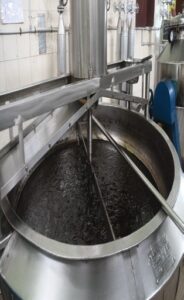 Ayurvedic medicines prepared with modern equipment
Ayurvedic medicines prepared with modern equipment
A rich aroma rode on clouds of smoke which filled the thatched-roof shed where a cauldron of oil and herbs simmered like a wizard’s brew over a wood fire. Stir, stir, stir – a man stood over the bubbling contents and swirled the viscous liquid around with a long-handled ladle. We witnessed this in the 1990s at an Ayurvedic spa that prided itself on making its own oils for various Ayurvedic therapies.
Fast forward to 2022 – to the modern-state-of-the-art factory of the Kairali Ayurvedic Group, the country’s leading Ayurvedic and wellness brand. Indeed, the group’s inception goes back way back to 1908, followed by the establishment of its first manufacturing unit in 1948, and its first treatment centre in Delhi in 1989. In 1999, Kairali’s picturesque healing village dedicated to pure Ayurveda saw light of day.
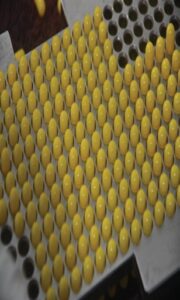 Traditional medicines in modern capsules
Traditional medicines in modern capsules
We were on a tour of their factory in Pollachi, Tamil Nadu, where tradition and modern technology tangoed in an intricate balancing act. While tall brass lamps, and urns with flowers bedeck the lobby, within, there’s the quiet hum of high tech– -technicians hunched over computer terminals to monitor the Ayurvedic concoctions that were brewing in large metal vats. The Kairali Group’s factory is reportedly the most modern manufacturing unit in the country, marrying modern processes and strict quality control with natural and organic ingredients, mentioned in the ancient scriptures. The company also banks on four generations of expertise in Ayurveda as the founders K. V. Ramesh and Gita Ramesh come from a line of Vaids (Ayurvedic doctors).
The sleek, modern glass-fronted factory, located on
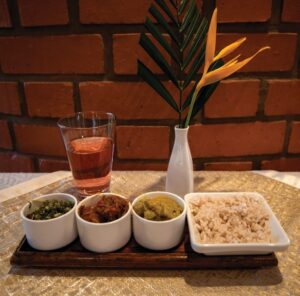 Healthy vegetarian ayurvedic cuisine
Healthy vegetarian ayurvedic cuisine
seven and a half acres of land, is backdropped by the Nilgiris and lush forests. We saw heaps of herbs stacked in one section of the factory (most are home grown in Palakkad, location of their award-winning healing village) where a botanist identified each root, stem and unrecognisable herb by name. “Every department has specialised knowledge,” said Abhilash Ramesh, the suave, young Executive Director of Kairali Ayurvedic Products, whose desk was stacked neatly with his group’s products, ready for a briefing of our band of journalists.
Of the expansive range of Ayurvedic supplements listed in the ancient scriptures, Kairali manufactures 77, including immunity boosters, health tonics, and curative formulas as well as skin care and body products totalling up to 350 products. “The processes are still the same,” said Abhilash.
“The ingredients are dried, washed, heated and cooled up to a certain temperature and then they are mixed in the correct proportion… It’s just that the processes are now more
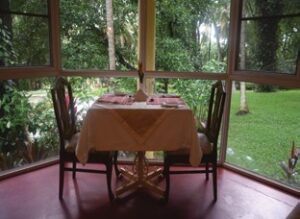 A table for two in a greenery-encased restaurant
A table for two in a greenery-encased restaurant
efficient. Yet it can take 4 to 7 days to manufacture a product.”
The Kairali Ayurvedic Product Division is divided between Spalab which includes patented drugs such as Lipidex, Spaliv, Spazyme, Mulberine researched and developed by the brand; Proprietary Products which mainly consists of Ayurvedic oils for massages either patented to Kairali or sourced from classical scriptures and concocted from herbs, flowers, fruits, barks of trees, milk and minerals; and all herbal internal medicines such as arishtas, asvas, lehyas, choornams, gulikas, bhasmas and gritham are formulated to treat disease without
side effects. “Both our herbal care beauty division as well as the Ayurvedic medicine division have seen consistent growth year on year,” revealed Abhilash.
During the pandemic, the demand for their Ayurvedic sanitizers and immunity boosters soared and 32 new Ayurvedic products are to be launched soon as Research and Development is an ongoing process. Indeed, Kairali Ayurvedic doctors adhere to Ayurvedic principles for product development. There is a Cosmetics Division, too, which manufactures soaps, shampoos,
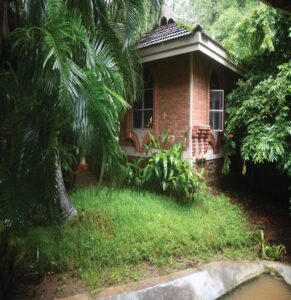 A villa snuggles amidst lush vegetation
A villa snuggles amidst lush vegetation
moisturisers, shower gels etc.
As we strolled around the factory, we saw nimble-fingered uniformed workers with masks and shower caps on, fill capsules with powder, and top up bottles with healing liquids. Dark brews bubbled and were mechanically stirred in huge vats only to emerge as smooth glutinous liquids.
Everywhere, we were enveloped in the fragrance of nature’s bounty, typical of an Ayurvedic factory where modern technology preserves an ancient system of wellness.
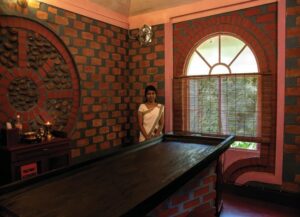 A therapy room at the healing village
A therapy room at the healing village
harnessing the knowledge of their forefathers who were traditional Ayurvedic doctors or vaids. Today, the group is spread across three continents, 10 countries and 35 locations and the healing village is billed as an Ayurvedic hospital in a resort setting. At one time, Kairali treated only overseas guests. Now, more and more under-exercised Indians with out-of-whack systems are checking in and opting to experience and rediscover their ancient heritage of good health and wellness “as well as seeking cures for long covid symptoms and chronic ailments,” revealed Gita Ramesh, managing director of the group.
“When the pandemic struck, Indians did not have the immunity and the power to fight it,” she said. Covid-battered, they are now flocking to Kairali, to detox their bodies flooded with high doses of steroids and antibiotics that they ingested to combat Covid. “We have had cases of long covid – inflamed thyroid, high fever, lingering fatigue, joint pain, insomnia, recently. Plus, the usual arthritis and de-addiction cases,” adds Gita. Addiction to drugs, smoking and alcohol can all be treated by Ayurveda. “Follow an Ayurvedic regimen of eating right – fresh seasonal food at the right time, oil your body, do yoga, meditate and avoid junk food, excessive drinking and partying,” she suggests as the best road map to good health. “Moderation is the key.” We had clearly ignored that dictum all our lives, as was evident in our weather-beaten look and parchment-like skin.
“Thirty years ago, no one knew about Ayurveda,” explained Gita who has published a number of books on the Ayurvedic diet and massages. This ancient knowledge was suppressed by the colonialists and initially people were hesitant and even apprehensive. “But once they got results, they were reassured,”she said. “In the old days, kings and nobility had a separate space for Ayurveda and vaids would go to their palaces and homes for 21-day treatments. Even today, in Kerala, we practice Ayurveda in our daily lives. The abhyanga massage if done daily prevents disease and is rejuvenating. This is why even old people in Kerala are healthy. Essentially, impaired digestion leads to disease,” she adds.
Kairali received a major facelift last year and all the 30 villas in the vastu-compliant property have been refurbished with new en suite bathrooms and are spacious and muted in their décor. A valambari conch shell in each room is said to emanate positive vibes while a stream meanders past each villa done in the Kerala style. The villas come with private sit-outs for night time stargazing and listening to the sawing of crickets and croaking of frogs. At dawn, we woke to tuneful bird song and, occasionally, the raucous cry of peacocks preening in the foliage. Thirty-five new species of plants and herbs have been planted recently.
The main therapy building which has also been expanded and refurbished is ensconced in leafy vegetation, with glimpses of greenery and natural light streaming in through glass skylights. Indoor plants glow green there and the space is fragrant with the aroma of freshly roasted and pounded herbs and spices. A post therapy relaxation space is where we chatted with other guests over sips of herbal tea – a lady from Sweden who had come for a de-tox and another Indian who was on a weight loss regimen.
We left after three days, feeling like we had recovered much of our sense of well-being and mojo, pummelled by a cruel pandemic that had been even-handed in its destruction of the world we once knew. We, too, vowed to return even if our yoga-weary joints protested. Our minds, now cleansed of nameless fears, longed to return to retrieve again and again that unique sense of quietude we had experienced at Kairali Healing Village.
Fact File
How to Reach
AIR
Coimbatore International Airport is the closest airport from where Kairali Healing Village in Palakkad district is a little over one and a half hours away. Kochi airport too is an option but is a two-hour drive away.
RAIL
Palakkad Railway station is the closest railway station and is half an hour away from the healing village.
ROAD
Taxis are available from the two airports and Palakkad railway station.
STAY
Kairali Healing Village has 30 villas and offers a number of packages but the line of treatment is generally decided by the resident doctors.
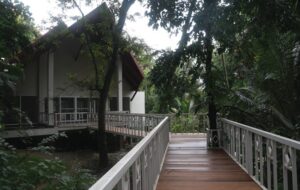 The new Yoga and meditation deck
The new Yoga and meditation deck
BEST TIME TO VISIT
Traditionally, according to Ayurveda, Ayurvedic therapies work well in the monsoons. However, Ayurveda therapies are effective year -round.
SIGHTS
Check out Malampuzah Dam, Tipu Sultan Fort, and Silent Valley National Park or get sucked into the Arabian Nights atmosphere of Palakkad market and return with bags full of spices.

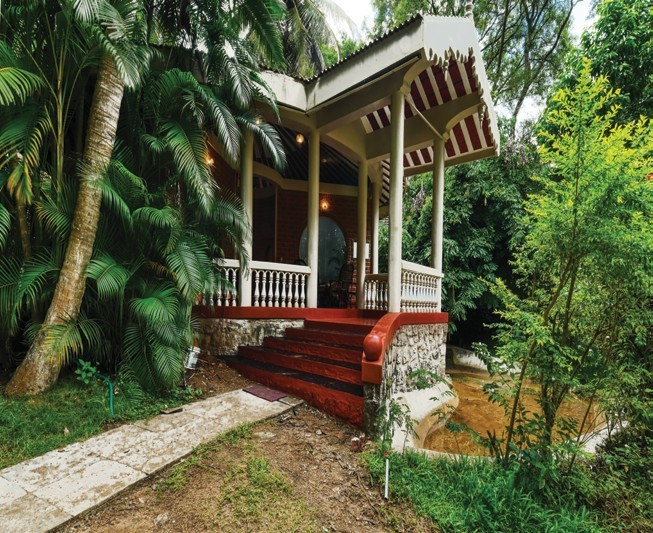
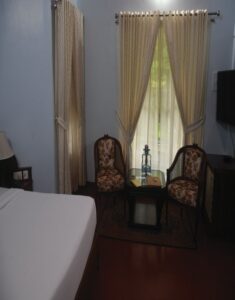

 Gustasp and Jeroo Irani are travel companions for whom life is a never-ending journey. Over the last 25 years they have travelled extensively across India and the globe, taking the rough with the smooth; sampling different cultures and cuisines. In the process they have trekked in the Australian Outback, slurped snake soup in HongKong, have danced with the Samburus in Africa, stayed with a local family in a Malay village, cracked the Da Vinci Code in Paris… For them, writing and photography are more than just freezing moments of that journey; it’s a
Gustasp and Jeroo Irani are travel companions for whom life is a never-ending journey. Over the last 25 years they have travelled extensively across India and the globe, taking the rough with the smooth; sampling different cultures and cuisines. In the process they have trekked in the Australian Outback, slurped snake soup in HongKong, have danced with the Samburus in Africa, stayed with a local family in a Malay village, cracked the Da Vinci Code in Paris… For them, writing and photography are more than just freezing moments of that journey; it’s a